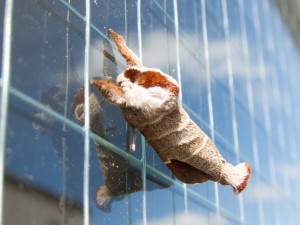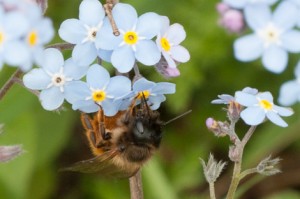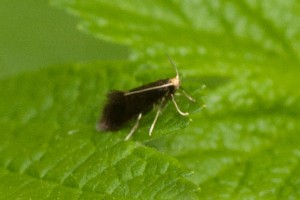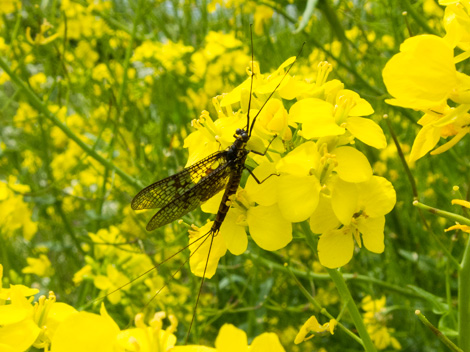The suggestion was made – ‘wouldn’t it be cool if you could watch insects in real time with the same magnification as with your macro lens?’ And yes, it would be but does such a thing exist, can you get closer than a few metres to look at insects with a pair of binoculars. Enter the Pentax Papilio in either 6.5x or 8.5x magnification.
The online reviews were very good, but I have to admit, that I was a bit skeptical of the one that said they could count the segments on the antennae of a butterfly. But, with a minimum focus distance of 0.5m and the potential to use them for birding as well I had to give them a go. I got the 6.5×21 version as it should make it easier to track an insect about.
First up, was a moth that I saw at work – it looked a bit tiny with the naked eye, but with the bins I saw texture on the wings, white lines across it and little furry feet. I have no idea about the segments in the antennae as it didn’t appear to have any. This is what it looked like through my point and shoot camera – and I could eventually manage to ID it as a chocolate tip moth. Very cute, very furry and sticking two fingers up to the moth people that wouldn’t come and do any moth trapping at work because we didn’t have any interesting moths – it is all relative!
 However, this was only a limited test and I needed to try them out in the garden and see what was there. First test – bees in the front garden zipping about the rosemary. I have been trying to ID them, and I know some are probably red mason bees, but others look different, and behave differently, rarely stopping to nectar at all, these looked much greyer, almost white on the thorax and head. My bins passed the first test. Not only did I get a good view of the female mason bees (as shown on forget-me-not below), but I discovered that the others were male mason bees. They aren’t grey at all, just very blonde and very furry with quite long antennae. I was confused as well by some of what thought were females but which looked grey on the thorax with a red abdomen – my new bins showed that this was a result of having lots of rosemary pollen stuck to their hairs! As a result I am fairly confident in my Osmia bicornis ID skills. It’s amazing how orange and how furry these bees look in close up!
However, this was only a limited test and I needed to try them out in the garden and see what was there. First test – bees in the front garden zipping about the rosemary. I have been trying to ID them, and I know some are probably red mason bees, but others look different, and behave differently, rarely stopping to nectar at all, these looked much greyer, almost white on the thorax and head. My bins passed the first test. Not only did I get a good view of the female mason bees (as shown on forget-me-not below), but I discovered that the others were male mason bees. They aren’t grey at all, just very blonde and very furry with quite long antennae. I was confused as well by some of what thought were females but which looked grey on the thorax with a red abdomen – my new bins showed that this was a result of having lots of rosemary pollen stuck to their hairs! As a result I am fairly confident in my Osmia bicornis ID skills. It’s amazing how orange and how furry these bees look in close up!
 I watched a couple of hoverflies, well, hovering, one was definitely a marmalade hoverfly, but I couldn’t ID the other, but I could even watch their legs and feet tentatively making contact with the rosemary flower as they touched down – amazing!
I watched a couple of hoverflies, well, hovering, one was definitely a marmalade hoverfly, but I couldn’t ID the other, but I could even watch their legs and feet tentatively making contact with the rosemary flower as they touched down – amazing!
A bigger test for the bins though was in the back garden – it is usually much gloomier due to the large amount of foliage shading the area. I wasn’t sure that I would find anything to look at, but I was wrong. I watched a spider tense itself under a leaf when a fly landed on the top surface, only to be thwarted as the fly took off again after a quick clean. I saw a tiny yellow and black fly on a hazel leaf that I wouldn’t have even noticed otherwise. It was less than 5mm long, yellow underneath, with orange legs and a yellow almost checkerboard pattern on the top of the abdomen / thorax. It had a yellow head with a blackish stripe between its eyes and thing yellow stripes on its scutellum. It is not the kind of thing I would be able to take a picture of, but I think I managed to ID it from my notes as a grass fly, Chlorops sp.
The good thing about the bins is that they show you things you would never have seen otherwise (either with or without a macro lens). I saw a moth crawl out from under a leaf. It was tiny and looked like a black speck and I probably would have thought it was just that if I hadn’t seen it arrive. It had glossy purple black wings and a yellow head and legs. It was so small I couldn’t even get a good picture with my macro lens. This is as good as it gets:

This is a fern smut moth Psychoides filicivora, I had never noticed them before amongst our many ferns! Now I’ve seen quite few of them crawling around at the bottom of the garden.
So, the verdict. The view through the bins is even better than through a macro lens – not least because it is in real time and works without a tripod in poor light. The only downside is that there is some barrel distortion, but it doesn’t ruin the view. Can you count the segments on a butterfly’s antenna? I still don’t know because I haven’t seen a butterfly since I got them, but my guess is yes.
My new bins are opening up a whole new world full of creatures or behaviours I’d never noticed before, and I’m afraid I’m going to be boring you with lots more mini beasts that are inhabiting the garden.



